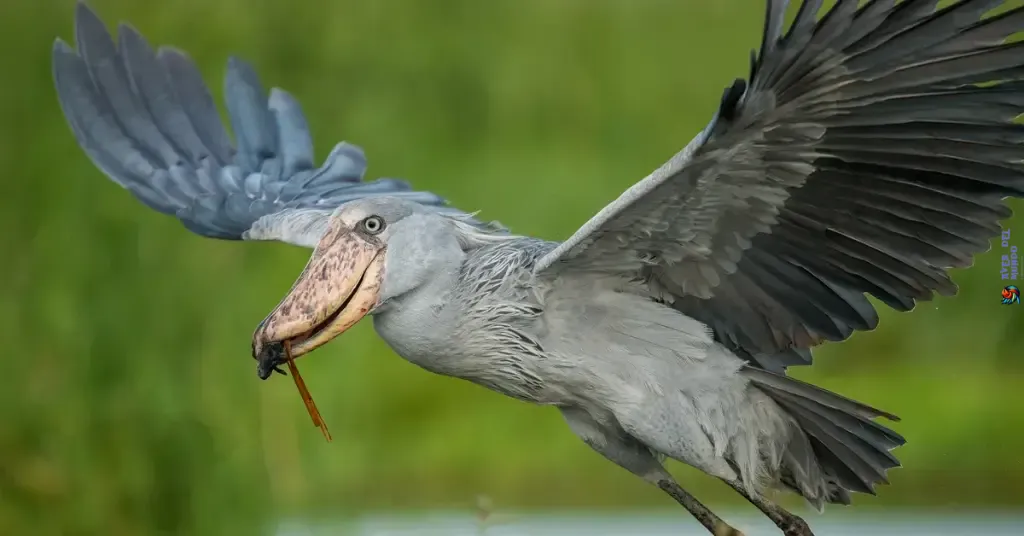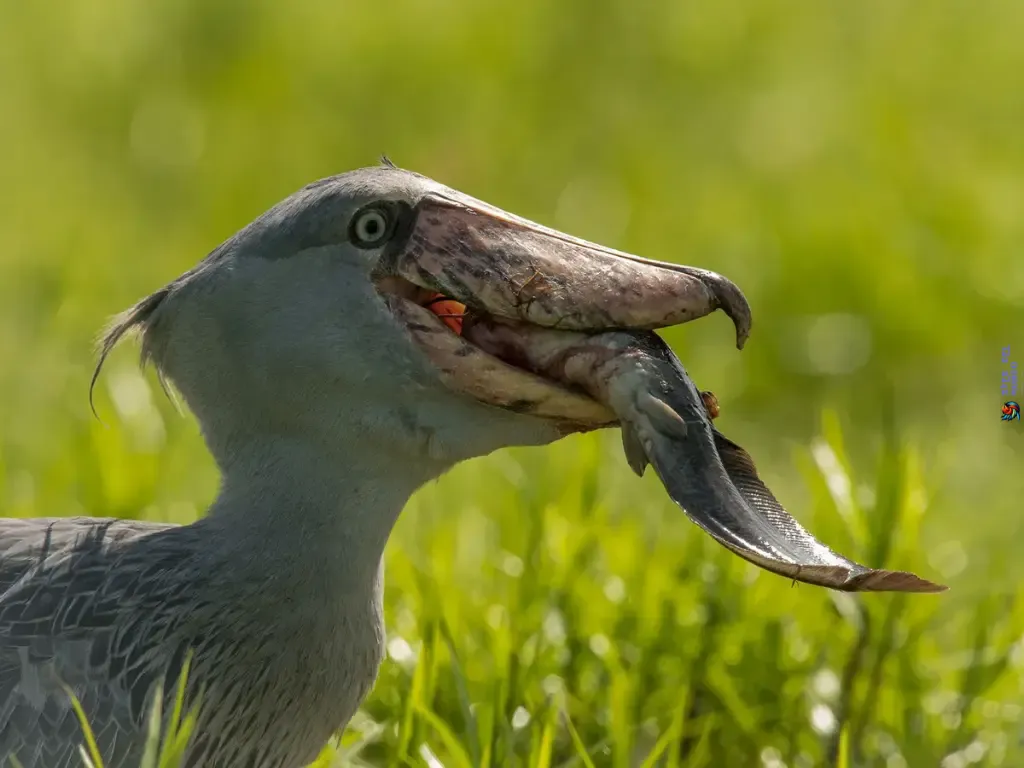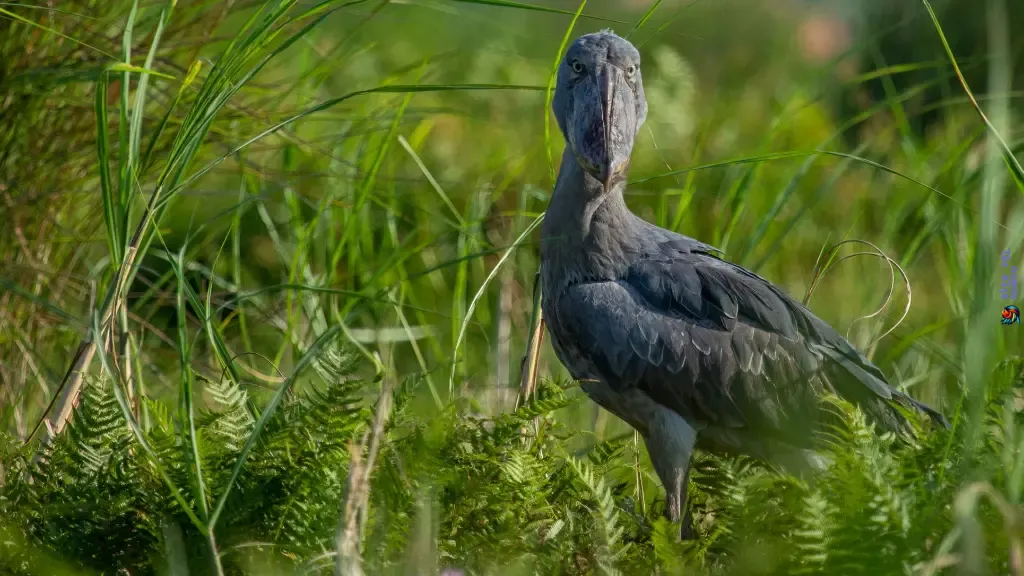Did you know that the shoebill, also known as the shoebill stork or shoebill bird, is classified as a vulnerable species? This fascinating bird, with its oversized shoe-shaped beak, faces numerous challenges in its natural habitat.
From habitat destruction to hunting, the shoebill’s population is in decline, making its conservation a matter of utmost importance. Join us as we explore the awe-inspiring world of the shoebill, from its unique behavior and physical characteristics to the efforts being made to protect this elusive African bird.

Shoebill Habitat and Distribution
The shoebill, also known as the shoebill stork or shoebill bird, thrives in the freshwater swamps and marshes of East Africa. Its distribution is closely tied to the presence of papyrus vegetation and lungfish in these habitats. Found in countries such as Uganda, Sudan, the Democratic Republic of the Congo, Zambia, Kenya, Ethiopia, Botswana, and Tanzania, the shoebill’s preferred habitat offers ideal conditions for its survival.
The African freshwater swamps provide a unique environment for the shoebill to flourish. Papyrus vegetation, characterized by tall grasses and reeds, forms dense thickets in the swamps, creating the ideal nesting and foraging spots for the shoebill. The extensive network of channels and waterways within these swamps provides the bird with abundant food sources.
The shoebill’s distribution is closely associated with African freshwater swamps and marshes, where the unique papyrus vegetation and the presence of lungfish provide optimal conditions for its survival.
The shoebill’s habitat, however, is under threat due to various human activities. The conversion of swamps and marshes into agricultural land and pastures for cattle grazing has led to the gradual loss and degradation of the shoebill’s preferred habitat. This loss of habitat poses a significant challenge to the conservation of this elusive bird species, highlighting the importance of protecting and preserving these fragile ecosystems.
To give you a better understanding of the shoebill’s habitat and distribution, here is a table summarizing the countries where it can be found:
| Country | Presence of Shoebill |
|---|---|
| Uganda | Yes |
| Sudan | Yes |
| Democratic Republic of the Congo | Yes |
| Zambia | Yes |
| Kenya | Yes |
| Ethiopia | Yes |
| Botswana | Yes |
| Tanzania | Yes |
Shoebill Facts and Physical Characteristics
The shoebill is a remarkable bird known for its distinct physical features. Its most recognizable characteristic is its large beak, which resembles a shoe and gives the bird its name. This unique beak is believed to be an adaptation for catching fish and other prey in the shallow waters of swamps and marshes.

Standing at an impressive height of 3.5 to 4.5 feet, the shoebill is one of the tallest birds in Africa. It is a relatively heavy bird, with an average weight ranging from 9 to 15.5 pounds.
The shoebill’s wingspan is equally awe-inspiring, measuring between 7.5 to 8.5 feet. This broad wingspan enables the bird to navigate its habitat effectively and cover long distances while hunting for food.
These physical characteristics contribute to the shoebill’s ability to thrive in its wetland habitat and make it an extraordinary species to behold.
| Physical Characteristics | Measurements |
|---|---|
| Large Beak | Resembles a shoe |
| Height | 3.5 to 4.5 feet |
| Weight | 9 to 15.5 pounds |
| Wingspan | 7.5 to 8.5 feet |
Shoebill Diet and Feeding Behavior
The shoebill, with its unique beak and hunting prowess, exhibits a specialized diet and fascinating feeding behavior in its wetland habitat. As a piscivorous bird, the shoebill primarily feeds on fish, making it an adept hunter in the aquatic landscape. However, its diet is not limited to fish alone, as it occasionally preys on other creatures.

The preferred prey of the shoebill includes lungfish, bichirs, tilapia, and catfish. These species provide a rich source of nutrients for the shoebill’s survival and growth. Being opportunist hunters, shoebills will also target frogs, snakes, snails, and rodents when fish are scarce or unavailable.
One of the remarkable aspects of the shoebill’s feeding behavior is its patient and strategic approach. It employs a hunting strategy that involves standing motionless for extended periods, blending seamlessly with the environment. Often compared to a statue, the shoebill waits patiently for the perfect moment to strike.
When the time is right, the shoebill launches a sudden attack on its unsuspecting prey, employing lightning-fast reflexes and precision. Its unique beak, resembling a shoe, plays a crucial role in prey capture. The sharp edges of its beak allow the shoebill to swiftly decapitate its catch, ensuring a quick and efficient kill.
Additionally, the shoebill exhibits nocturnal feeding behavior. It takes advantage of the cover of darkness to hunt, increasing its chances of successful captures. During nighttime hunts, shoebills can often be observed standing on floating vegetation, further enhancing their stealth and camouflage.

The image above provides a visual depiction of a shoebill engaging in its natural prey capture behavior, showcasing the bird’s unique features and its wetland habitat.
«The shoebill’s patient and stealthy hunting strategy, combined with its distinctive beak, makes it a formidable predator in the wetland ecosystem.»
In summary, the shoebill’s diet predominantly consists of fish, with lungfish, bichirs, tilapia, and catfish being its preferred prey. However, it adapts to the availability of other prey such as frogs, snakes, snails, and rodents. Its hunting behavior involves motionless waiting and sudden attacks, with its specialized beak ensuring efficient prey capture. As a nocturnal hunter, the shoebill takes advantage of the cover of darkness to enhance its hunting success, further showcasing its remarkable adaptation to its wetland environment.
Conservation Status of the Shoebill
The shoebill is classified as a vulnerable species by BirdLife International due to various conservation challenges. The declining population of this elusive African bird is primarily attributed to habitat destruction, disturbance, and hunting.
«Conservation is a crucial factor in protecting and preserving the shoebill’s habitat and population.»
Habitat destruction poses a significant threat to the survival of the shoebill. Swamps and marshes, which are the bird’s preferred habitats, are being transformed into agricultural land and pastures for cattle grazing. This loss and degradation of habitat limit the shoebill’s breeding, nesting, and hunting opportunities.
Disturbance from human activities also contributes to the decline of the shoebill population. The presence of humans and their associated noise can disrupt the bird’s natural behaviors, such as hunting and nesting.
Hunting, both legal and illegal, further exacerbates the shoebill’s declining population. Despite being a protected species in many countries, the demand for shoebills in the zoo trade remains high. This demand encourages illegal capture and trade, resulting in further reduction of the wild population.
| Conservation Challenges | Impact |
|---|---|
| Habitat Destruction | Loss of breeding, nesting, and hunting opportunities. |
| Disturbance | Disruption of natural behaviors. |
| Hunting | Reduction of the wild population. |
Estimating the exact population size of the shoebill is challenging, but estimates range from 5,000 to 8,000 individuals. This vulnerable species requires immediate conservation efforts to protect its habitat and ensure its survival.
Conservation initiatives focusing on habitat restoration, law enforcement, and raising awareness about the importance of preserving the shoebill are critical. Collaborative efforts between governments, conservation organizations, and local communities will play a vital role in securing a sustainable future for this remarkable African bird.
Unique Characteristics of the Shoebill

The shoebill possesses several unique characteristics that set it apart from other bird species. Its prehistoric appearance, slow flapping, long beak, and decapitation behavior make it a fascinating and remarkable creature.
Prehistoric Appearance
The shoebill’s oversized shoe-shaped beak and tall stature give it a distinctive and ancient look. With its unique physical features, it resembles a creature from a prehistoric era.
Slow Flapping
Compared to other birds, the shoebill has one of the slowest flapping rates, averaging approximately 150 times per minute. This slow and deliberate flapping allows it to navigate its wetland habitat with precision and efficiency.
Long Beak
The shoebill’s beak is truly impressive, reaching lengths up to 24cm and widths up to 20cm. This elongated beak enables the bird to capture large prey, including fish and even baby crocodiles.
Decapitation Behavior
One of the most distinctive traits of the shoebill is its decapitation behavior. The bird’s beak has razor-sharp edges, allowing it to quickly decapitate its prey. This behavior is crucial for capturing and consuming prey in its wetland habitat.

Overall, the shoebill’s unique characteristics, such as its prehistoric appearance, slow flapping, long beak, and decapitation behavior, make it a truly remarkable and captivating bird species.
Behavior and Adaptations of the Shoebill
The shoebill exhibits specific behaviors and adaptations that contribute to its survival in its wetland habitat.
As an ambush predator, the shoebill is a master of patience, often standing perfectly still for long periods, waiting for unsuspecting prey to come within striking distance. This behavior allows the shoebill to blend seamlessly into its surroundings, making it a highly efficient hunter.
Interestingly, the shoebill is primarily a nocturnal feeder, taking advantage of the cover of darkness to hunt. This behavior offers several advantages, allowing the bird to avoid competition with diurnal predators and providing it with a strategic edge in catching its prey.
During courtship or as a form of greeting, the shoebill engages in a unique behavior known as bill clattering. This involves the bird rapidly snapping its beak together, creating a sound reminiscent of a machine gun. The purpose of this behavior is not yet fully understood, but it is thought to play a role in establishing dominance or attracting mates. The bill clattering is often accompanied by other vocalizations such as high-pitched whines and cow-like «moo» noises, adding to the bird’s distinctive repertoire.
In addition to its intriguing feeding and social behaviors, the shoebill also exhibits solitary breeding habits. Typically, there are less than three nests per square kilometer, indicating a preference for privacy during the breeding season. While nesting, shoebills fiercely defend their territory from other individuals, exhibiting remarkable dedication to protect their offspring and ensure their survival.
All these behaviors and adaptations collectively contribute to the shoebill’s success as an elusive and highly adapted species, perfectly suited to its wetland environment.
| Behavior/Adaptation | Description |
|---|---|
| Ambush Predator | The shoebill’s ability to remain motionless for extended periods allows it to stealthily ambush prey. |
| Nocturnal Feeding | Hunting primarily during the cover of darkness provides the shoebill with a strategic advantage. |
| Bill Clattering | The distinctive behavior of rapidly clattering its bill, possibly for establishing dominance or attracting mates. |
| Solitary Breeding Habits | Displaying a preference for privacy during the breeding season, with fewer nests per square kilometer. |
Cultural Significance and Conservation Efforts
The shoebill holds cultural significance in various African traditions and beliefs. It is prominently featured in ancient Egyptian wall paintings and hieroglyphics, showcasing its enduring presence throughout history. In fact, the shoebill’s old Arabic name, «Abu-markub,» translates to «Father of a Slipper,» which pays homage to its distinctively shaped beak resembling a shoe.
However, the cultural reverence for the shoebill has inadvertently contributed to its decline. The demand for the bird in the zoo trade is remarkably high, with individuals commanding staggering prices of up to $20,000. This makes the shoebill one of the most sought-after and expensive birds in this trade.
Unfortunately, this high demand fuels illegal capture and trade, exacerbating the dwindling population of the species in the wild. The extraction of shoebills from their natural habitat threatens their survival and disrupts the delicate balance of their ecosystems.
| Threats | Impact |
|---|---|
| Habitat Destruction | Loss of breeding, nesting, and hunting grounds |
| Disturbance | Disruption of shoebill behaviors and breeding patterns |
| Hunting | Direct impact on the population |
| Impact of Zoo Trade | Illegal capture and trade further reduce the wild population |
To address these significant threats, conservation efforts are imperative. Organizations and individuals work tirelessly to protect the shoebill and its habitat, implementing strategies that range from habitat restoration and protection to community education and involvement. By raising awareness about the conservation needs of the shoebill, these efforts seek to foster sustainable practices and reduce the impact of human activities on the bird’s population.
Preserving the cultural significance of the shoebill while embracing conservation practices is crucial for its long-term survival. By recognizing the important role this elusive bird plays in African traditions and ecosystems, we can strive to ensure its continued existence for generations to come.
African Bird Folklore and Beliefs
African tribes have long cherished a rich tapestry of folklore and beliefs surrounding birds. These magnificent creatures were revered as bringers of fertility and prosperity, much like migratory herds heralding abundance and growth. The arrival of birds signified the bountiful blessings of nature, inspiring awe and reverence among different tribes.
For some African communities, birds held a deeper symbolism, representing the highest state of perfection and life. It was believed that human souls could achieve this exalted state by being reborn as birds, soaring freely in the sky. This profound connection between birds and spirituality fostered a profound respect and admiration for these winged beings.
Conservation practices in African tribes were guided by ancient laws and guidelines, emphasizing the need to protect birds and preserve their habitats. Disobeying these laws, such as destroying bird eggs, carried severe consequences, underscoring the value that communities placed on safeguarding these magnificent creatures. African folklore also recognized the undeniable link between birds and trees, as migratory birds played a vital role in dispersing seeds, nurturing new life, and sustaining the delicate balance of nature.
Understanding and honoring African bird folklore and beliefs serve as a guiding principle for modern-day conservation practices. By embracing the wisdom passed down through generations, we can forge a deeper connection with our avian companions, and work towards ensuring the protection and preservation of these extraordinary creatures for generations to come.



